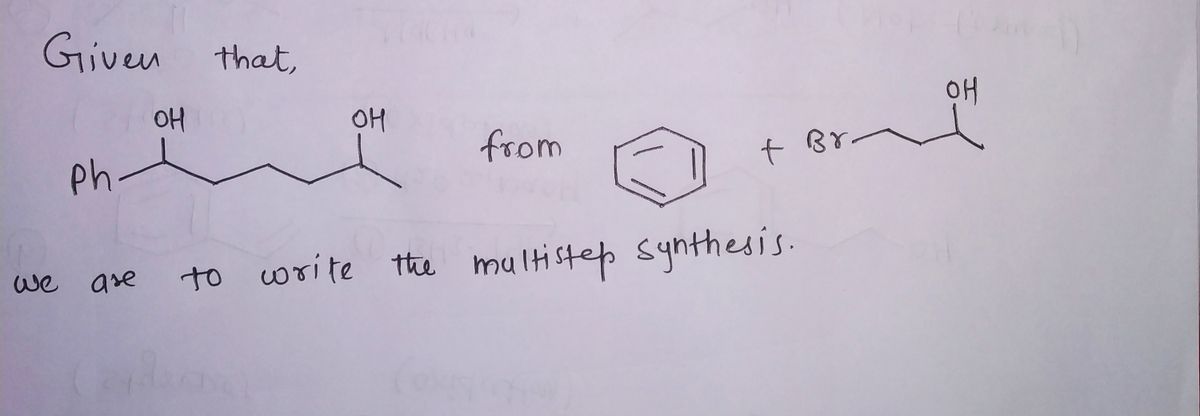Chemistry
10th Edition
ISBN:9781305957404
Author:Steven S. Zumdahl, Susan A. Zumdahl, Donald J. DeCoste
Publisher:Steven S. Zumdahl, Susan A. Zumdahl, Donald J. DeCoste
Chapter1: Chemical Foundations
Section: Chapter Questions
Problem 1RQ: Define and explain the differences between the following terms. a. law and theory b. theory and...
Related questions
Question
Outline a multi-step laboratory synthesis of the target shown below starting from indicated molecules. You may use any other reagents as necessary. No mechanisms.

Transcribed Image Text:### Synthesis Pathway: Target Molecule
#### Objective
The goal is to synthesize the target compound, a diol with a phenyl group, from the given starting materials.
#### Target Molecule
- **Structure:** The target molecule is a compound with two hydroxyl groups (OH) on a carbon chain, with a phenyl group (Ph) attached.
#### Starting Materials
1. **Benzene Derivative:**
- Structure: Represented by a simple benzene ring, which may participate in a reaction to form part of the target molecule’s structure.
2. **Bromo Alcohol:**
- Structure: A carbon chain with a bromine (Br) substituent and a hydroxyl (OH) group, which may serve as a building block or reactant in the synthesis process.
#### Reaction Overview
The synthesis involves the use of a benzene derivative and a bromo alcohol. The reactions may proceed through a series of steps that incorporate these functional groups appropriately into the target diol structure.
#### Diagram Explanation
- The diagram visually represents the chemical structures of the target molecule and the starting materials, illustrating how the synthesis might be approached from a structural perspective.
This layout and information are designed to help students or learners understand the connection between starting materials and the target molecule through typical organic synthesis strategies.
Expert Solution
Step 1

Step by step
Solved in 2 steps with 2 images

Knowledge Booster
Learn more about
Need a deep-dive on the concept behind this application? Look no further. Learn more about this topic, chemistry and related others by exploring similar questions and additional content below.Recommended textbooks for you

Chemistry
Chemistry
ISBN:
9781305957404
Author:
Steven S. Zumdahl, Susan A. Zumdahl, Donald J. DeCoste
Publisher:
Cengage Learning

Chemistry
Chemistry
ISBN:
9781259911156
Author:
Raymond Chang Dr., Jason Overby Professor
Publisher:
McGraw-Hill Education

Principles of Instrumental Analysis
Chemistry
ISBN:
9781305577213
Author:
Douglas A. Skoog, F. James Holler, Stanley R. Crouch
Publisher:
Cengage Learning

Chemistry
Chemistry
ISBN:
9781305957404
Author:
Steven S. Zumdahl, Susan A. Zumdahl, Donald J. DeCoste
Publisher:
Cengage Learning

Chemistry
Chemistry
ISBN:
9781259911156
Author:
Raymond Chang Dr., Jason Overby Professor
Publisher:
McGraw-Hill Education

Principles of Instrumental Analysis
Chemistry
ISBN:
9781305577213
Author:
Douglas A. Skoog, F. James Holler, Stanley R. Crouch
Publisher:
Cengage Learning

Organic Chemistry
Chemistry
ISBN:
9780078021558
Author:
Janice Gorzynski Smith Dr.
Publisher:
McGraw-Hill Education

Chemistry: Principles and Reactions
Chemistry
ISBN:
9781305079373
Author:
William L. Masterton, Cecile N. Hurley
Publisher:
Cengage Learning

Elementary Principles of Chemical Processes, Bind…
Chemistry
ISBN:
9781118431221
Author:
Richard M. Felder, Ronald W. Rousseau, Lisa G. Bullard
Publisher:
WILEY